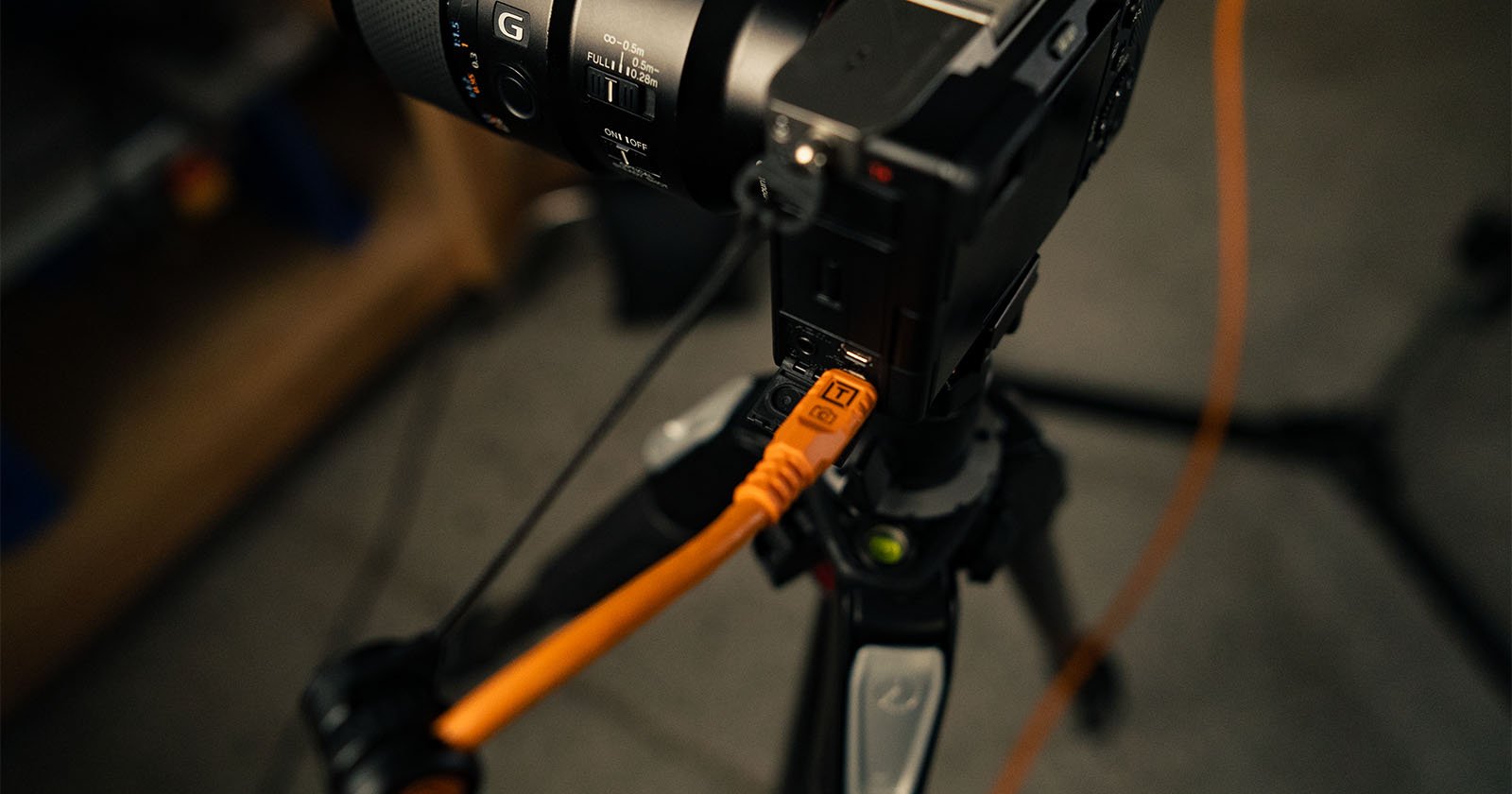
Tether Tools has long been a key player in the tethered photography community. This specialized but vital niche of the photography market has very specific cable requirements, which, when faced with increasing issues with USB-C PD, forced Tether Tools back to the drawing board. The company developed a brand-new USB-C cable, Optima, to deal with growing USB concerns on modern cameras.
USB-C cables are generally great, powering many valuable features in modern cameras. From in-camera charging to external recording to SSDs, USB-C has improved the lives of most photographers. However, not all photographers who rely on tethered shooting for their work have benefited from advancing cable technology.
However, over the past few years, more and more cameras have struggled with tethered shooting over traditional USB-C cables, and even Tether Tools’ older purpose-built ones. While not every photographer has had issues, and not even all photographers with the same troublesome models, like Fujifilm GFX cameras and Canon EOS R models, Tether Tools has continually received reports from photographers of dropped connections while shooting.
When this sort of things happens, the first thing Tether Tools does is talk to its customers and camera manufacturers to troubleshoot the issues. After extensive study and conversation, the culprit was located: power delivery over USB-C.
Some manufacturers recommended that photographers disable USB-C PD in their cameras when shooting tethered, while other models provided no such option at all. It was becoming increasingly evident that something more needed to be done, and that meant creating a new USB-C cable specifically designed for photographers.
Removing the Power from USB-C
Ultimately, Tether Tools decided that the best option would be to remove the high-wattage power delivery from its USB-C cable for tethering. After all, the issue is that certain cameras require too much power while shooting tethered, which interferes with the critical data transmission.
High-resolution cameras these days can capture RAW image files exceeding 100 MB, which is a significant amount of data to send quickly over USB-C from a camera to a connected computer. Photographers need high-resolution images on their computer instantly when shooting tethered.
These same high-resolution cameras are also increasingly power-hungry, which places a secondary demand on USB-C cables. Lots of data is one thing, but lots of data and lots of power is an entirely different beast.
For the lucky photographers who don’t have any issues with the older cables, that’s excellent. However, for the growing number of people dealing with dropped connections and troublesome file transfers, Optima is the solution. Tether Tools tells PetaPixel that it has received no reports of photographers experiencing issues shooting tethered using the new cables, including many who had frequent problems with the older cable.
The key engineering achievement was to custom-build circuitry and software inside a USB-C cable that completely blocks high levels of power transmission. Cameras can still trickle-charge over the Optima cable, similar to the type of charging typically found in older USB-A cables. What the Optima cable prevents is high levels of power transmission.
“USB-C cables have a different power protocol,” Tether Tools tells PetaPixel. “They can do up to 240 watts of power, which is sizable. You could even power a blender off that, laptops, all kinds of stuff.”
“The cable negotiates that power. When you plug in your camera or your computer, it says, ‘I need 90 watts of power to charge.’ And then the other end of that cable says, ‘Okay, give me 90 watts of power.’”
It’s a sort of handshake between two connected devices that is negotiated by the USB-C cable. When shooting tethered, which Tether Tools emphasizes is a particular, demanding usage of a USB cable, this handshake can get in the way.
The new circuitry prevents high-wattage power delivery by interfering with the power negotiation between two connected devices, in this case, a camera and a computer. The custom chip inside the cable essentially says, “No, I don’t need power. You may think I need it, but I don’t. So don’t send it.”
“It’s when you combine 90 watts of power in addition to 200 megabyte files, shooting off 20 frames at a time… that’s when there’s a problem,” Tether Tools says.
It’s not possible to tell a camera not to pull power through the cable only when it’s not actively shooting, although that would be an excellent feature for future cameras to implement.
“The only solution that works for our particular needs is to eliminate the power entirely,” Tether Tools says.
A Simple Idea and a Complicated Engineering Challenge
Although Tether Tools says that figuring out the problem initially was the biggest challenge of all, actually making the Optima cable was no walk in the park.
“It’s not as easy as you would think,” the company admits.
USB-C standards are straightforward on the matter of power delivery. USB-C cables have power delivery, and that’s that. Existing chips exist within that standard.
“So we worked with our engineers to redesign those chips,” Tether Tools says. “And while doing that, we prioritized the data transfer in the chips.”
On the Optima cable, one end has a camera icon, and the other has a computer icon. These are important. The host is the host, and the source is the source, and the cable is designed around this particular directional flow.
The Optima cable always knows which way the data is flowing and prioritizes speed. It takes just milliseconds to move the files, and Optima is the fastest and most reliable USB-C cable for tethered shooting on the market, according to Tether Tools.
Then there are the “timer chips,” which are featured in Tether Tools’ prior USB cables. These chips are housed in little containers located along the Optima cables. These timer chips are explicitly built for the most data-hungry camera setups, including medium-format cameras. The timer chips enhance the signal, ensuring it travels along the USB-C cable quickly.
Tether Tools notes that the USB standard actually only covers cables up to 10 feet long. Anything longer than that, like the more than 30-foot cables used by Tether Tools, operates outside that standard. While it’s possible to push data through a long USB cable without hardware acceleration, it’s not ideal for demanding users.
Who Needs the New Optima Cable?
The new Optima cable is a must-have for photographers who have been having issues with their camera in a tethered environment. It solves their problems.
What about photographers who haven’t had issues? The Optima cable is still the best cable that Tether Tools makes, and has higher performance and improved reliability than its older cables. It is also future-proof, as its data ceiling is far beyond what even the most expensive, high-resolution cameras today require.
There is also a trade-up program available through authorized retailers. Photographers can trade in their existing 15 or 31-foot tethering USB cables to get 20% off the new Optima cables. A full list of participating retailers is available on the Tether Tools website.
The Tether Tools TetherPro Optima 10G USB-C cables start at $49.99 and come in 6, 10, 15, and 31-foot (1.8, 3, 4.6, and 9.4-meter) lengths. The cables are available in high-vis orange and black colorways.



